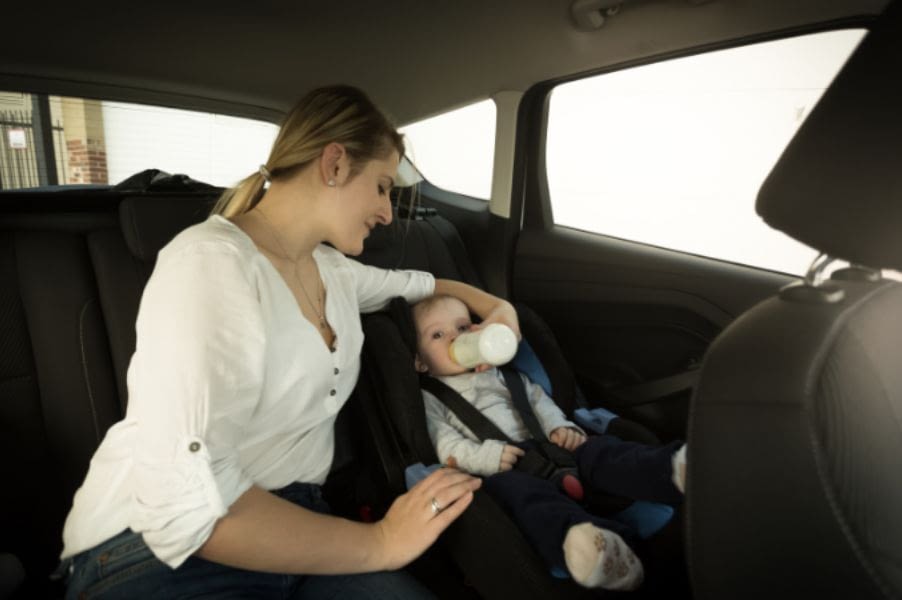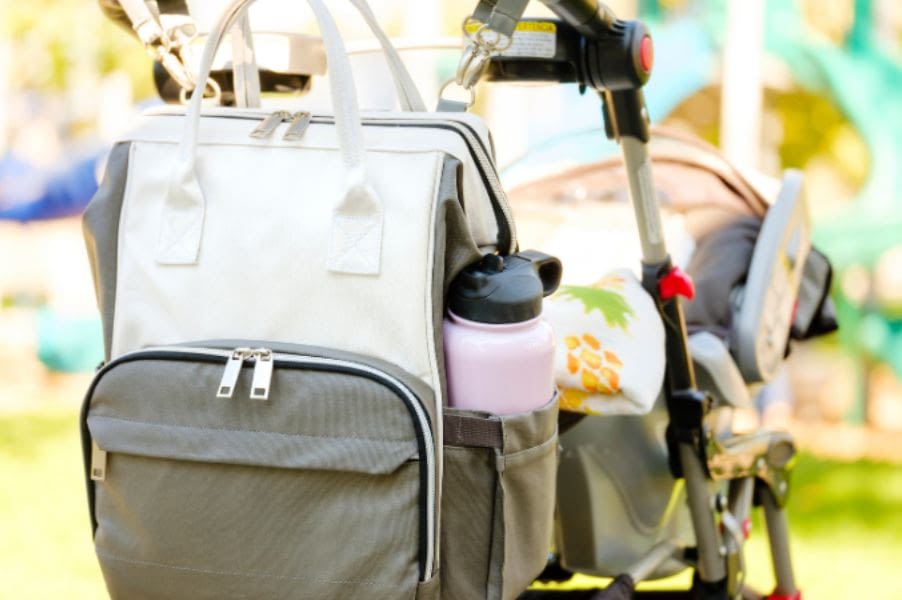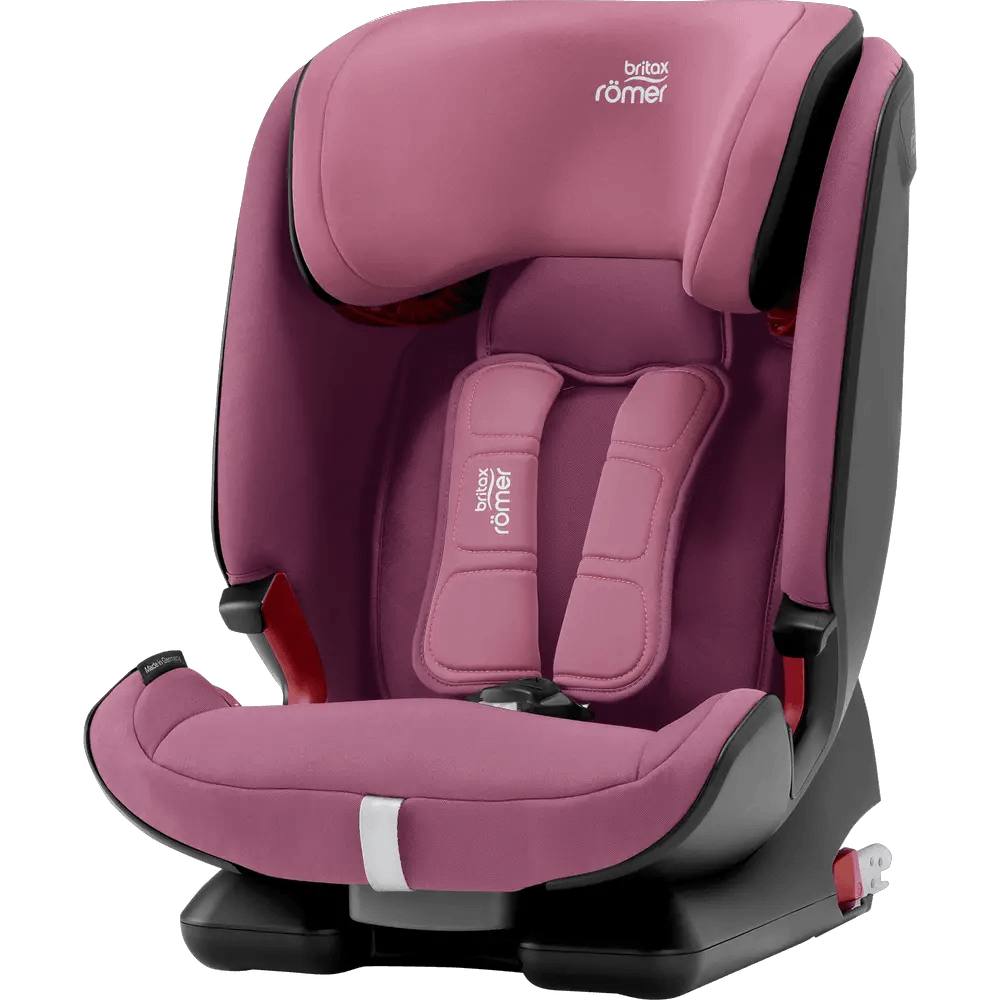The joy of parenting comes with a never-ending list of questions, particularly regarding your child’s well-being while on the road. It’s about the destination and how you manage the journey. One common query new parents have is regarding the safety of feeding their baby while the little one is snug in a car seat.
Can you feed a baby in a car seat? Let me provide you with reliable safety tips and best practices.
Why Safety Comes First?
While multitasking is a skill many parents get used to, feeding your infant in a car seat requires extra caution. The decision might seem innocuous, but there are risks and safety considerations that can’t be ignored. Understanding why the correct approach to feeding your baby during your travels is imperative for their safety is crucial.
Understanding the Risks: Is it safe to feed baby in car seat?
Feeding a baby in a car seat isn’t a task to be taken lightly. Significant hazards can arise from being in this position, particularly during car movement. Infant Car Seat Safety experts stress that improper support during feeding may lead to choking hazards or issues with digestion. Let’s delve into the possible dangers and their impact on your infant’s safety and well-being.
The dangers of car seat feeding
One significant risk is the lack of proper support for the baby’s head and neck while feeding in a car seat. Without adequate support, there’s a higher likelihood of the baby’s airway becoming obstructed by food, leading to choking. Additionally, the semi-upright position of a car seat may not be conducive to optimal digestion, potentially causing discomfort or regurgitation in infants.
Moreover, feeding a baby in a moving vehicle introduces additional hazards. The car’s motion can disrupt the feeding process, making it difficult for the baby to swallow correctly and increasing the risk of choking. Additionally, sudden stops or maneuvers could cause spills or accidents especially if a car seat is not installed with a car seat base, further endangering the baby’s safety.
Furthermore, prolonged periods spent in a car seat, even without feeding, can contribute to issues such as plagiocephaly (flat head syndrome) or torticollis (tightening of neck muscles), especially if the baby’s head remains in the same position for an extended period.
Parents must understand these risks and prioritize safer feeding practices for their infants, such as stopping the car and taking the baby out of the car seat for feeding or feeding them before or after the car journey. While it may require some inconvenience or adjustment, ensuring the baby’s safety and well-being should always be the top priority.
How and can you feed a baby in a car seat?
The first step is to ensure that the car seat is properly installed and that your baby is securely fastened with accurately adjusted straps. However, what comes next? Here’s where you must consider the proper feeding methods that suit a car seat scenario and explore specialized accessories such as a car seat bottle holder designed to provide extra support.
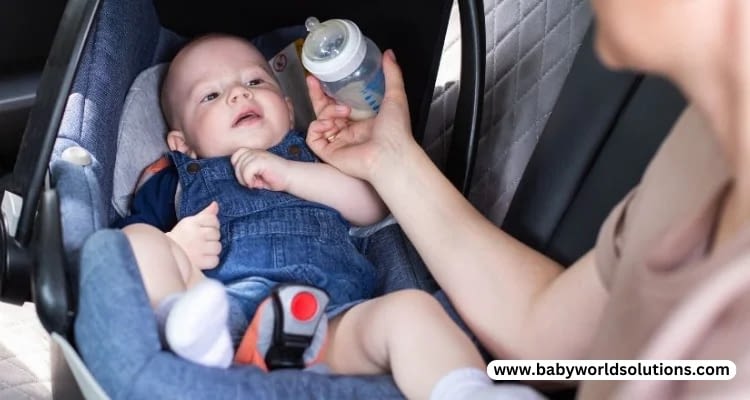
Proper Positioning
A certified child passenger safety technician emphasizes, “Keeping an eye on your baby’s airway is critical when they’re in a car seat.” Ensuring that your baby’s head is not slumping forward is vital.
Utilizing Accessories
Opt for accessories crafted explicitly for car seats that protect your baby’s posture and provide support during feeding times. However, the use of such tools should in no way replace direct supervision.
Review of Car Seat Feeding Accessories
The baby car monitor stands out when considering feeding accessories crafted for car seat use. This innovative gadget allows parents to keep a vigilant eye on their child from the driver’s seat. Its ability to provide live footage of your baby ensures you can monitor their safety, positioning, and overall comfort without turning your head. This minimizes distractions while driving and adds a layer of safety, especially during long commutes.
In addition to monitors, specialized bottle holders that attach securely to the car seat can be lifesavers. They are designed to hold the bottle at an appropriate angle, mimicking how a parent would have it, which can help reduce the risk of choking. However, it’s important to note that even with these accessories, nothing surpasses the importance of stopping the vehicle and attending to your baby’s needs when possible, as they can’t entirely remove all the risks associated with feeding in a car seat.
Direct Supervision
A pediatrician would advise, “Never compromise on active supervision while the baby is feeding in a car seat. Direct observation helps you respond to any feeding difficulties immediately.”
Breastfeeding safely while in the car
Breastfeeding in a car presents unique challenges; however, it is feasible with the right approach. If you’re a passenger, ensure that the car is parked safely before starting to nurse, as both you and your baby’s safety need to avoid breastfeeding while the vehicle is moving.
Use nursing covers for privacy if desired, and always prioritize your comfort and the baby’s latch by adjusting your seat position as needed. Remember, a child passenger safety expert would warn against ever breastfeeding with the baby in the car seat; always hold the baby in your arms, away from airbags and potential harm.
How to travel with breast milk by car?
Traveling with breast milk by car requires careful planning to ensure its safety and freshness. The key to this process is maintaining the correct temperature. Use insulated coolers with ice packs to store expressed milk. A lactation consultant would want you to know, “Breast milk can be stored in a cooler with ice packs for up to 24 hours.” It’s also advisable to have a backup plan in case of unexpected delays, such as identifying locations where you could use a power source to connect a portable cooler or breast pump.
How to Burp Baby in Car Seat?
Burping your baby during car travels can seem challenging, but it’s important for their comfort—especially if they’ve just been fed. Due to potential movement restrictions, it’s essential to follow a cautious approach to avoid discomfort or risks.
A pediatrician advises, “Position your baby’s car seat at the semi-upright angle recommended for travel and give gentle pats on their back.” Make sure always to support your baby’s head and neck.
You may also utilize the car’s movement as a natural soothing method for your baby to help in releasing gas. Always park safely when attending to your baby’s needs if you’re the driver.
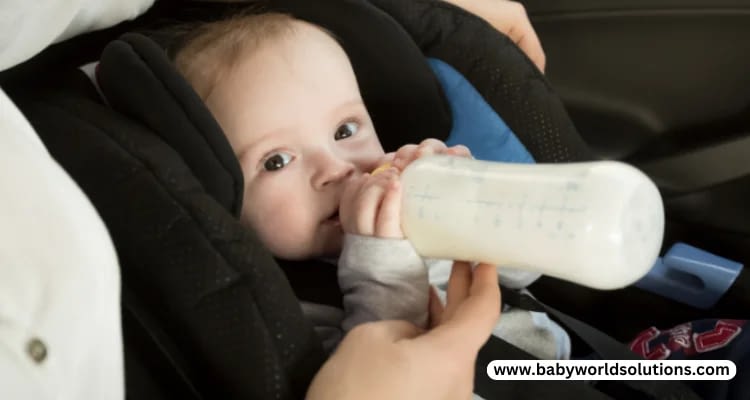
Best Practices while traveling with a 1 month old by car
Developing a routine and understanding your baby’s needs can make all the difference. Baby Feeding Tips often highlight the importance of sticking to a schedule.
- Timing and Frequency: It is conducive to aligning feeding times with breaks in your drive. A nutritionist would suggest, “Take regular breaks during your journey to feed your baby to maintain both safety and comfort.”
- Preparing and Storing Food: How you prepare and store your baby’s milk can be crucial. Temperature control and immediate accessibility are factors you’ll need to consider.
- Recognizing Cues: An experienced parent will tell you how essential it is to recognize signs of hunger and fullness in your baby. It might mean the difference between a peaceful drive and a distressing one.
Alternatives: Feeding Safely While Traveling
While feeding in a car seat might seem like the only option at times, there are safe alternatives to consider. From planning to creating a feeding-friendly environment, these options can reassure the mindful parent.
Planning Breaks
Taking the time to stop at a calm location for feeding can provide a safe environment for your baby to eat and give them (and you) a much-needed break from the confines of the car seat.
Portable Feeding Gear
Investing in compact, travel-friendly feeding gear can be a lifesaver for feeding outside the car. They should be easy to clean and quick to set up, all while being comfortable for your baby.
Conclusion: Can you feed a baby in the car seat?
Prioritizing your baby’s safety always comes first. While is it safe to feed baby in car seat might yield different opinions, the consensus leans towards caution and preparedness. We must underscore the advice and guidance provided by professionals in the domain.
Remember, each child’s needs and reactions can vary. A development expert captures it well: “Attention and attunement to a baby’s needs during feeding times are fundamental regardless of the setting.”
1 Visit today

